Baldachin
A baldachin, or baldaquin (from Italian: baldacchino), is a canopy of state typically placed over an altar or throne. It had its beginnings as a cloth canopy,[lower-alpha 1] but in other cases it is a sturdy, permanent architectural feature, particularly over high altars in cathedrals, where such a structure is more correctly called a ciborium when it is sufficiently architectural in form.Baldachins are often supported on columns, especially when they are disconnected from an enclosing wall.[1] A cloth of honour is a simpler cloth hanging vertically behind the throne, usually continuing to form a canopy. It can also be used for similar canopies in interior design, for example above beds, and for processional canopies used in formal state ceremonies such as coronations, held up by four or more men with poles attached to the corners of the cloth.
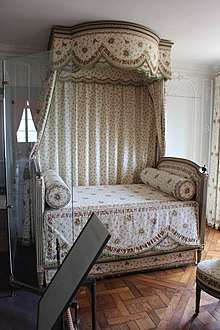
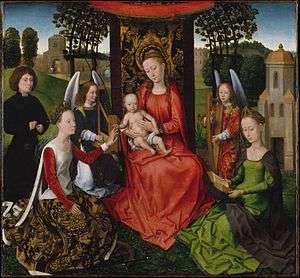
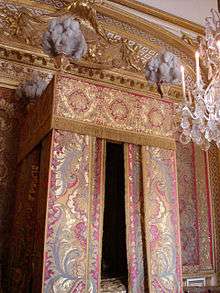
"Baldachin" was originally a luxurious type of cloth from Baghdad, from which name the word is derived, in English as "baudekin" and other spellings. Matthew Paris records that Henry III of England wore a robe "de preciosissimo baldekino" at a ceremony at Westminster Abbey in 1247.[2] The word for the cloth became the word for the ceremonial canopies made from the cloth.
Canopies of state
In the Middle Ages, a hieratic canopy of state (or "estate"), cloth of honour, or cloth of state was hung above the seat of a personage of sufficient standing, as a symbol of authority. The seat under such a canopy of state would normally be raised on a dais. The cloth above a seat generally continued vertically down to the ground behind the seat. Emperors and kings, reigning dukes and bishops were accorded this honour. In a 15th-century manuscript illumination the sovereign Grand Master of the Knights Hospitaller in Rhodes sits in state to receive a presentation copy of the author's book. His seat is raised on a carpet-covered dais and backed with a richly embroidered dosser (French, "dos"). Under his feet is a cushion, such as protected the feet of the King of France when he presided at a lit de justice. The King of France was also covered by a mobile canopy during his Coronation, held up on poles by several Peers of France. The Virgin Mary in particular, is very often shown sitting under a cloth of honour in medieval and Renaissance paintings where she is shown enthroned with saints.
The cloth was often simply a luxurious textile, often imported and with rich patterns, as in brocades, but might have heraldic elements. French kings are often shown with blue cloths patterned with the gold fleur-de-lys. Margaret Beaufort, mother of Henry VII in her portrait by an anonymous artist, c. 1500 prays under a canopy of estate; one can see the dosser against the gilded leather wall-covering and the tester above her head (the Tudor rose at its center) supported on cords from the ceiling. The coats-of-arms embroidered or woven into the tapestry are of England (parted as usual with France) and the portcullis badge of the Beauforts.
Sometimes, as in the presentation miniature Jean Wauquelin presenting his 'Chroniques de Hainaut' to Philip the Good by Rogier van der Weyden, the cloth continues over the seat, and then to the floor. In the summer of 1520, a meeting was staged between Francis I of France and Henry VIII of England, where the ostentatious display of wealth and power earned the meeting-place the name of The Field of Cloth of Gold. The canopy of estate may still be seen in most formal throne rooms.
State bed
The state bed, intended for receiving important visitors and producing heirs before a select public, but not intended for sleeping in,[3] evolved during the second half of the seventeenth century, developing the medieval tradition of receiving visitors in the bedroom, which had become the last and most private room of the standard suite of rooms in a Baroque apartment. Louis XIV developed the rituals of receptions in his state bedchamber, the petit lever to which only a handful of his court élite might expect to be invited. The other monarchs of Europe soon imitated his practice; even his staunchest enemy, William III of England, had his "grooms of the bedchamber", a signal honour.
The state bed, a lit à la Duchesse—its canopy supported without visible posts— was delivered for the use of Queen Marie Leszczyńska at Versailles, as the centrepiece of a new decor realized for the Queen in 1730–35.[lower-alpha 2] Its tester is quickly recognizable as a baldachin, serving its time-honoured function; the bedding might easily be replaced by a gilded throne. The queens of France spent a great deal of time in their chambre, where they received the ladies of the court at the morning lever and granted private audiences. By the time Marie Antoinette escaped the mob from this bedroom, such state beds, with the elaborate etiquette they embodied, were already falling out of use. A state bed with a domed tester designed in 1775-76 by Robert Adam for Lady Child at Osterley Park[lower-alpha 3] and another domed state bed, delivered by Thomas Chippendale for Sir Edwin Lascelles at Harewood House, Yorkshire in 1773[4] are two of the last English state beds intended for a main floor State Bedroom in a non-royal residence.
St. Peter's Basilica

Pope Urban VIII commissioned Gian Lorenzo Bernini to design and construct a large structure that would be placed over the main altar, believed to be above the tomb of Saint Peter, in the new St. Peter's Basilica. The canopy imitated cloth in bronze, as did many subsequent imitations. This famous and spectacular feature is generally called the "Baldacchino", though strictly it is a ciborium.
Bernini's design for the Baldacchino incorporated giant solomonic columns inspired by columns that ringed the altar of the Old St. Peter's. These columns were originally donated by Constantine, and a false tradition asserts they are the columns from the Temple of Jerusalem. The lowest parts of the four columns of Bernini's Baldachin have a helical groove, and the middle and upper sections of the columns are covered in olive and bay branches, which are populated with a myriad of bees and small putti. Pope Urban VIII's family coat of arms, those of the Barberini family, with their signature bees, are at the base of every column.
All of these combine to create a feeling of upward movement.
Processional canopy
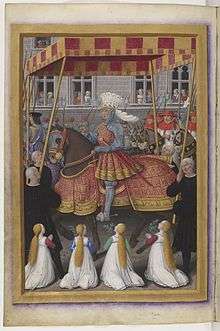
A baldachin may also be used in formal processions, including Royal entries, coronation or funeral processions, to signify the elite status of the individual it covers. The origins of such an emblematic use in Europe lay in the courts of the Neo-Assyrian state, adopted in Athens perhaps as early as the late seventh century BC, but relegated to the use of women by the late fifth century (compare parasol).[5]
Such canopies might be made of anything from muslin to heavy brocade, or even constructed of less flexible materials, and are supported by poles, whether affixed to a carriage, or carried by people walking on each side. An Egyptian Pharaoh, for example, was escorted both in life and in death by such a canopy of estate.
Francisco Franco, the ruler of Spain from 1939 to 1975, frequently walked under a baldachin after formally proclaiming Spain a monarchy—a privilege he appropriated as de facto regent for life.
Surname Baldacchino
The surname Baldacchino comes from the artisans who used to make the Baldachin. The surname is found mainly in the islands of Malta and Sicily, particularly in Agrigento and Naro.
Gallery
- The Grand Master of the Knights Hospitaller at Rhodes under a canopy of estate, on a dais: there is a cushion under his feet.
 Margaret Beaufort, Queen Mother, at prayer, by an anonymous artist, about 1500.
Margaret Beaufort, Queen Mother, at prayer, by an anonymous artist, about 1500.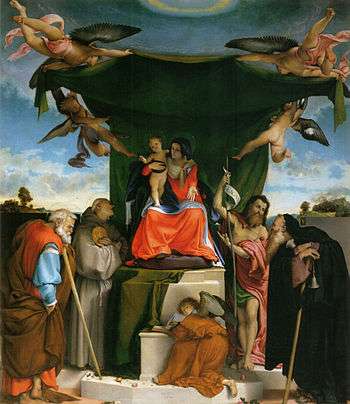 Held over the Virgin by angels, in an altarpiece by Lorenzo Lotto
Held over the Virgin by angels, in an altarpiece by Lorenzo Lotto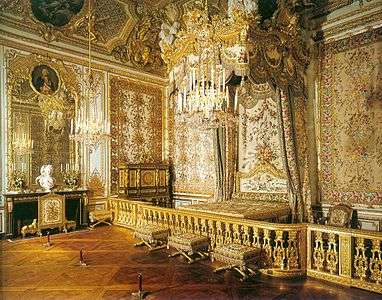 At Versailles, the Chambre de la Reine features the centrally-placed state bed delivered for Queen Maria Leszczinska.
At Versailles, the Chambre de la Reine features the centrally-placed state bed delivered for Queen Maria Leszczinska.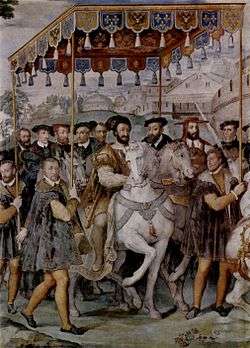 King Francis I of France, Charles V, and Cardinal Alessandro Farnese
King Francis I of France, Charles V, and Cardinal Alessandro Farnese A baldachin in Empire style simply adds visual importance to a daybed
A baldachin in Empire style simply adds visual importance to a daybed- Baldachin in the 'Hall of State' at Stockholm Palace, Sweden.

Notes
- Baldac is a medieval Latin form for Baghdad, whence fine silks reached Europe.
- The hangings were rewoven for Marie Antoinette. The present hangings, made at Lyon by the same firm that delivered the originals, replicate the hangings as they were in 1787.
- Of this grandiose bed Horace Walpole asked in a private letter "what would Vitruvius think of a dome decorated by a milliner?"
References
- "Baldachin | architecture". Encyclopedia Britannica. Retrieved 2020-08-12.
- Richard Ettinghausen et al., The Art and Architecture of Islam: 650-1250, 1987, Yale University Press (Yale/Penguin History of Art)
- Peter K. Thornton, Authentic Decor: the Domestic Interior 1620-1920, (London, 1985) and Seventeenth-Century Interior Decoration in England, France and Holland, (New Haven & London, 1981).
- Annabel Westman and Aasha Tyrrell, "The Restoration of the Harewood State Bed" (on-line Archived 2006-03-17 at the Wayback Machine)
- M. C. Miller, "The Parasol: An Oriental Status-Symbol in Late Archaic and Classical Athens," The Journal of Hellenic Studies, 112 (1992) 91-105.
Further reading
- "baldachin (architecture)". Encyclopœdia Britannica.
- Peterson, John Bertram (1907). . In Herbermann, Charles (ed.). Catholic Encyclopedia. 2. New York: Robert Appleton Company.
External links
| Wikimedia Commons has media related to Baldachins. |
| Wikisource has the text of the 1911 Encyclopædia Britannica article Canopy. |
- Burgundian example, King René's Tournament Book, BnF
.png)